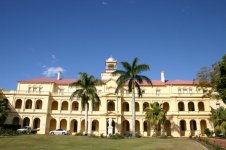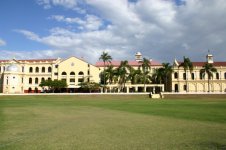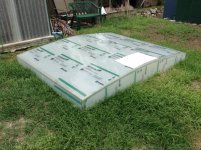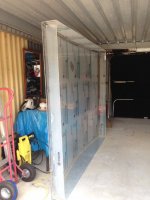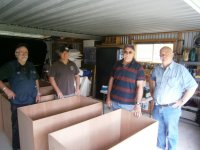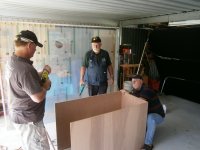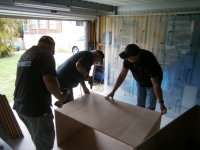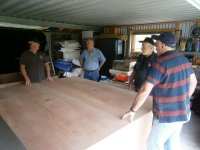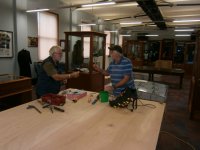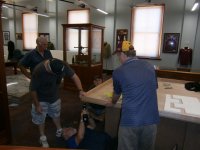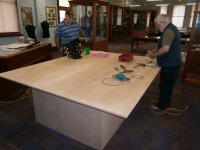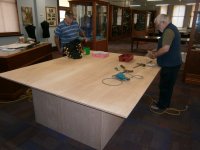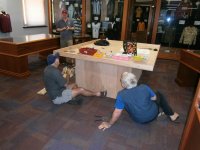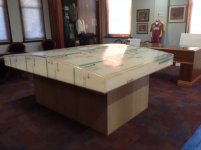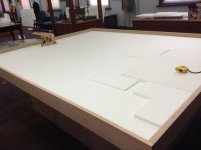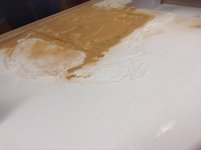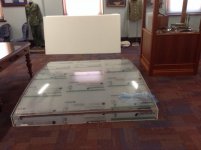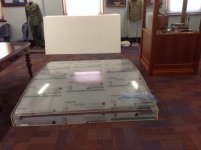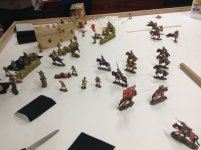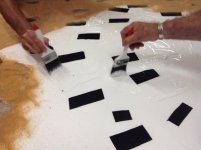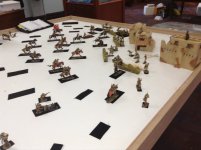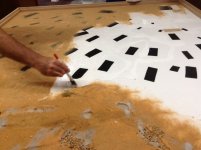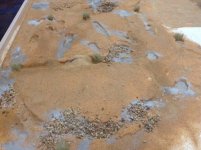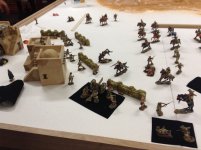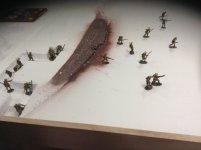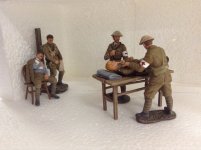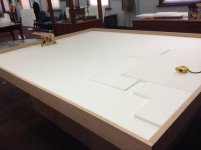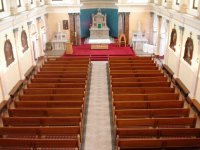Jack
Major
- Joined
- Dec 16, 2011
- Messages
- 6,347
In 1974 my family took a caravan holiday from Brisbane to Canberra, the highlight of which was a visit to The Australian War Memorial. The Memorial has always tread a very fine line between museum and national shrine and reflects the work of Charles Bean, our greatest historian. He travelled with the Australian troops for the entire duration of the First World War and was responsible for the Official Histories of the conflict, both as author and editor. They are a landmark in our national history and in the writing of official histories generally. The highlight of this highlight was a series of large dioramas charting the experience of the Australian soldier in our first major war. They are truly magnificent, particularly the one of Lone Pine (1915) and the later ones from the Western Front.
In the middle of the year the opportunity arose to be part of a team of toy soldier and history enthusiasts tasked with constructing a series of dioramas inspired by those in the Memorial for placement in a museum managed and run by St Joseph’s Nudgee College, established in 1891 and now one of the States most prestigious educational institutions. The team consists of some Treefroggers and associated enthusiasts, with the main participants being Brett (The Military Workshop), Bob (Fitzgibbon), Waynepoo (Wayne), Phil (Phil) and Jack (hereafter known as the member with no particular skill, but a hell of a lot of fun to be around). This thread will be a record of the construction of the dioramas leading up to the commemoration ceremonies. Funding was provided by a number of grants. The grant money was used for the display cases and diorama making materials. The collectors mentioned were generous in lending more than 150 figures, thus sparing the funding bodies the additional expense of purchasing them outright. Logistical support has been generously provided by The Military Workshop and Capital Transport.
The Museum is located on the second floor of a heritage listed building. It overlooks the main rugby field and is the main construction in the third stage of the campus development. Although a building constructed in 1904 may not sound old to our Northern Hemisphere friends, by our standards it is early Bronze Age. The Museum and the attached Rugby Museum is roughly the size of four classrooms and is one of the largest College based museums in the country. The College has a student population of just over 1500 and though it was still relatively small in 1914 (between 100 and 250 students in those years) and run by the (very, very Irish) Irish Christian Brothers, almost 300 Old Boys enlisted, with 53 losing their lives.
The two major dioramas each measure 2.4 metres by 2 metres and are covered by a perspex lid. One will represent a charge of the Light Horse against a Turkish town inspired by the charge at Beersheba in 1917. This diorama will make use of King and Country’s magnificent Australian Light Horse series. The second large diorama will represent a trench attack on the Western Front making use of William Britains’ equally fine series. Later dioramas will include WW 1 military aviation and a series of vignettes marking the progress of the war in which use will be made of figures, vehicles and aircraft manufactured by Thomas Gunn and John Jenkins.
The construction of the tables were driven by a series of concerns. Although generous funding was available, every dollar spent on them has repercussions for the actual displays and the opening ceremony. The access to the museum (narrow hallways etc) meant that some of the construction had to be completed in the museum itself. Naturally weight was a consideration. The tables were constructed under the direction of Phil, Bob and Wayne and made use of three modular supports with two large sheets as the diorama top. These were assembled in Phil’s large man shed and in the museum itself. They even let me use the drill once but I fear that was only to laugh. Having constructed the base two strips of wood of different heights were attached at right angles to each of the four sides, creating a lip on which the perspex lid would sit. The tables were lined with a thin cover of foam as a base and then thicker pieces to allow for the constriction of trenches. When we lifted the perspex cover on and it fitted perfectly it was a ‘wow’ moment … not quite man on the moon but still pretty satisfying!
The Light Horse diorama is at present eighty percent complete. It was tackled first as it was a more straightforward creation than the moonscape of the Western Front. The thick foam was augmented in places with off cuts to provide different heights. The placement of the figures and buildings was mapped out and marked by the use of adhesive felt. If the table moves slightly this will prevent the scratching of the bases. The figures were then removed. The application of turps and the subsequent melting of sections of foam allowed for a natural looking series of depressions, thus avoiding an un-natural evenness to the terrain. PVA glue was then liberally applied with paint brushes, and then sand of differing grades was sprinkled across the relevant areas. Once completed a slight spray of water brought the glue to the surface (how does Bob know these things?) and the further addition of different coloured sand to avoid an unnatural sameness to the terrain. This section is now drying and awaiting the addition of the figures on Sunday. The team will then tackle the Western Front diorama which promises to be an even greater challenge and will take a lot more time.
We will add pictures as the display develops but based on the quality of the ALH diorama I am eagerly looking forward to the next stage. As a group we are looking for the display to be more than a one off and see the opportunity for a real continuity of dioramas, large and small, that make use of the wonderful figures that the manufacturers are rolling out month after month. Next year being the bicentenary of Waterloo, there are plans already afoot to create a massed cavalry charge, hence my request in the K&C thread for the production of the plastic/resin figures so that massed ranks are possible. The discussion in the movie thread (I am quite the hijacker of threads!!) about a Dambusters dio complete with dam top and 1/48th scale Lancaster was also the result of a brain storming session. We found once we started talking, the options appeared limitless between us we have quite a collection of K&C North Africa which could make use of the ALH diorama base, we have Napoleonic cavalry laid on, and we have a soft spot for a D-Day Dio although we will need some of the Brisbane ETO collectors on board to provide figures. I would love a Battle of Britain or Bomber Command Airfield as well but all up that seems enough ideas for a couple of years already. Wayne even offered the suggestion of a fleet review, which makes one think of Jutland for 2016 or … or …
In the middle of the year the opportunity arose to be part of a team of toy soldier and history enthusiasts tasked with constructing a series of dioramas inspired by those in the Memorial for placement in a museum managed and run by St Joseph’s Nudgee College, established in 1891 and now one of the States most prestigious educational institutions. The team consists of some Treefroggers and associated enthusiasts, with the main participants being Brett (The Military Workshop), Bob (Fitzgibbon), Waynepoo (Wayne), Phil (Phil) and Jack (hereafter known as the member with no particular skill, but a hell of a lot of fun to be around). This thread will be a record of the construction of the dioramas leading up to the commemoration ceremonies. Funding was provided by a number of grants. The grant money was used for the display cases and diorama making materials. The collectors mentioned were generous in lending more than 150 figures, thus sparing the funding bodies the additional expense of purchasing them outright. Logistical support has been generously provided by The Military Workshop and Capital Transport.
The Museum is located on the second floor of a heritage listed building. It overlooks the main rugby field and is the main construction in the third stage of the campus development. Although a building constructed in 1904 may not sound old to our Northern Hemisphere friends, by our standards it is early Bronze Age. The Museum and the attached Rugby Museum is roughly the size of four classrooms and is one of the largest College based museums in the country. The College has a student population of just over 1500 and though it was still relatively small in 1914 (between 100 and 250 students in those years) and run by the (very, very Irish) Irish Christian Brothers, almost 300 Old Boys enlisted, with 53 losing their lives.
The two major dioramas each measure 2.4 metres by 2 metres and are covered by a perspex lid. One will represent a charge of the Light Horse against a Turkish town inspired by the charge at Beersheba in 1917. This diorama will make use of King and Country’s magnificent Australian Light Horse series. The second large diorama will represent a trench attack on the Western Front making use of William Britains’ equally fine series. Later dioramas will include WW 1 military aviation and a series of vignettes marking the progress of the war in which use will be made of figures, vehicles and aircraft manufactured by Thomas Gunn and John Jenkins.
The construction of the tables were driven by a series of concerns. Although generous funding was available, every dollar spent on them has repercussions for the actual displays and the opening ceremony. The access to the museum (narrow hallways etc) meant that some of the construction had to be completed in the museum itself. Naturally weight was a consideration. The tables were constructed under the direction of Phil, Bob and Wayne and made use of three modular supports with two large sheets as the diorama top. These were assembled in Phil’s large man shed and in the museum itself. They even let me use the drill once but I fear that was only to laugh. Having constructed the base two strips of wood of different heights were attached at right angles to each of the four sides, creating a lip on which the perspex lid would sit. The tables were lined with a thin cover of foam as a base and then thicker pieces to allow for the constriction of trenches. When we lifted the perspex cover on and it fitted perfectly it was a ‘wow’ moment … not quite man on the moon but still pretty satisfying!
The Light Horse diorama is at present eighty percent complete. It was tackled first as it was a more straightforward creation than the moonscape of the Western Front. The thick foam was augmented in places with off cuts to provide different heights. The placement of the figures and buildings was mapped out and marked by the use of adhesive felt. If the table moves slightly this will prevent the scratching of the bases. The figures were then removed. The application of turps and the subsequent melting of sections of foam allowed for a natural looking series of depressions, thus avoiding an un-natural evenness to the terrain. PVA glue was then liberally applied with paint brushes, and then sand of differing grades was sprinkled across the relevant areas. Once completed a slight spray of water brought the glue to the surface (how does Bob know these things?) and the further addition of different coloured sand to avoid an unnatural sameness to the terrain. This section is now drying and awaiting the addition of the figures on Sunday. The team will then tackle the Western Front diorama which promises to be an even greater challenge and will take a lot more time.
We will add pictures as the display develops but based on the quality of the ALH diorama I am eagerly looking forward to the next stage. As a group we are looking for the display to be more than a one off and see the opportunity for a real continuity of dioramas, large and small, that make use of the wonderful figures that the manufacturers are rolling out month after month. Next year being the bicentenary of Waterloo, there are plans already afoot to create a massed cavalry charge, hence my request in the K&C thread for the production of the plastic/resin figures so that massed ranks are possible. The discussion in the movie thread (I am quite the hijacker of threads!!) about a Dambusters dio complete with dam top and 1/48th scale Lancaster was also the result of a brain storming session. We found once we started talking, the options appeared limitless between us we have quite a collection of K&C North Africa which could make use of the ALH diorama base, we have Napoleonic cavalry laid on, and we have a soft spot for a D-Day Dio although we will need some of the Brisbane ETO collectors on board to provide figures. I would love a Battle of Britain or Bomber Command Airfield as well but all up that seems enough ideas for a couple of years already. Wayne even offered the suggestion of a fleet review, which makes one think of Jutland for 2016 or … or …


